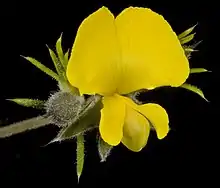Gompholobium aristatum
Gompholobium aristatum is a species of flowering plant in the family Fabaceae and is endemic to the south-west of Western Australia. It an erect shrub that typically grows to a height of 10–80 cm (3.9–31.5 in). It flowers between July and December producing yellow, pea-like flowers.[2] This species was first formally described in 1837 by George Bentham in Stephan Endlicher's Enumeratio plantarum quas in Novae Hollandiae ora austro-occidentali ad fluvium Cygnorum et in sinu Regis Georgii collegit Carolus Liber Baro de Hügel from specimens collected in the Swan River Colony.[3][4] The specific epithet (aristatum) means "awned", referring to the leaves.[5]
| Gompholobium aristatum | |
|---|---|
 | |
| Scientific classification | |
| Kingdom: | Plantae |
| Clade: | Tracheophytes |
| Clade: | Angiosperms |
| Clade: | Eudicots |
| Clade: | Rosids |
| Order: | Fabales |
| Family: | Fabaceae |
| Subfamily: | Faboideae |
| Genus: | Gompholobium |
| Species: | G. aristatum |
| Binomial name | |
| Gompholobium aristatum | |
| Synonyms[1] | |
| |
Gompholobium aristatum grows on sandplains and in winter-wet depressions in the Avon Wheatbelt, Geraldton Sandplains, Jarrah Forest and Swan Coastal Plain biogeographic regions of south-western Western Australia.[2]
References
- "Gompholobium aristatum". Australian Plant Census. Retrieved 28 July 2021.
- "Gompholobium aristatum". FloraBase. Western Australian Government Department of Biodiversity, Conservation and Attractions.
- "Gompholobium aristatum". APNI. Retrieved 28 July 2021.
- Bentham, George; Endlicher, Stefan F.L. (ed.); Fenzl, Eduard (ed.); Bentham, George (ed.); Schott, Heinrich W. (ed.) (1837). Enumeratio plantarum quas in Novae Hollandiae ora austro-occidentali ad fluvium Cygnorum et in sinu Regis Georgii collegit Carolus Liber Baro de Hüge. p. 29. Retrieved 28 July 2021.
{{cite book}}:|first2=has generic name (help) - Sharr, Francis Aubi; George, Alex (2019). Western Australian Plant Names and Their Meanings (3rd ed.). Kardinya, WA: Four Gables Press. p. 137. ISBN 9780958034180.